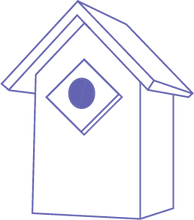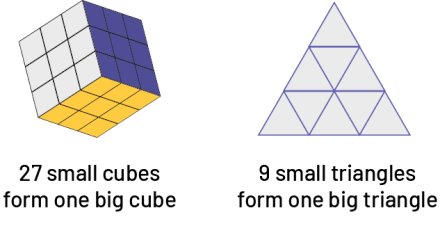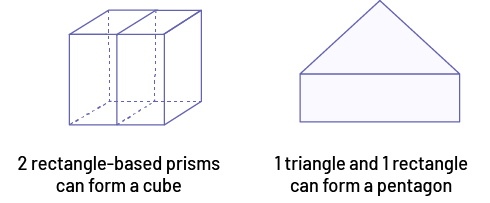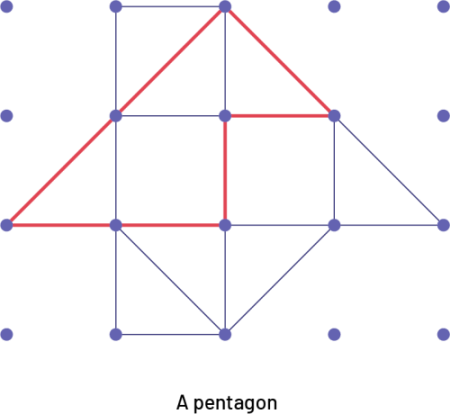E1.2 Compose and decompose various structures, and identify the two-dimensional shapes and three-dimensional objects that these structures contain.
Skill: Composing and Decomposing Structures
The toddler has fun building (with LEGO®, wooden blocks), assembling (puzzles, shapes) and breaking down (cutting, folding, tearing drawings) different geometric shapes. The child understands at an early age that by stacking blocks, they create a tower, and by lining up blocks, they create a wall. The child refers to their construction as a tower and a wall because they see them as a whole.
Similarly, when observing objects in their environment, students first describe them as a whole and gradually name the parts and characteristics of certain attributes.
Example

The student will first say, ”This is a birdhouse.“
Then they will say, ”It's a birdhouse with a pointed roof, a round window, and rough walls.“
When asked to reproduce the birdhouse with three-dimensional objects, the student realizes that they need different three-dimensional objects. Later, they will learn to name them.
The child initially builds houses without naming the three-dimensional objects used. Later, they build a copy of a given model using three-dimensional objects. They may be able to identify the cubes, then the prisms. The student will later be able to identify all the three-dimensional objects used.
Here are some possibilities of three-dimensional objects that can be used to build the birdhouse:
- A triangle-based prism and a rectangle-based prism;
- Two cubes and two triangle-based prisms;
- Five triangle-based prisms.
The number will vary depending on the size of the three-dimensional objects.
It is important to allow students to experiment and create freely when they first build, assemble, or decompose geometric shapes. In addition, it is important to allow them to use a variety of materials or objects such as:
- wooden or plastic blocks of different shapes and sizes;
- modeling clay;
- straws, toothpicks, pipe cleaners;
- tiles;
- tangrams;
- pattern blocks;
- some string;
- newspapers.
Example
During guided activities, students will realize that:
- some shapes can be assembled to create the same shape, but a different size, for example:
 The first image is a "rubix cube," under the cube it labeled: "27 small cubes form a large cube.
Second image is a: "triangle" under the triangle is labeled: "9 small triangles form a large triangle."
The first image is a "rubix cube," under the cube it labeled: "27 small cubes form a large cube.
Second image is a: "triangle" under the triangle is labeled: "9 small triangles form a large triangle."
- some shapes can be assembled to form new shapes, for example:
 Image Two shapes. The first shape is: "a rectangular prism." It’s labeled: "2 rectangular prisms
can form a cube."The second picture is a: " pentagon. " It’s labeled: "a triangle and a rectangle can form a
pentagon."
Image Two shapes. The first shape is: "a rectangular prism." It’s labeled: "2 rectangular prisms
can form a cube."The second picture is a: " pentagon. " It’s labeled: "a triangle and a rectangle can form a
pentagon."
Construction, assembly, and decomposition activities help students understand several concepts related to spatial sense. For example, students deepen their understanding of the concepts of edge and vertex by building three-dimensional objects, and their understanding of the concept of face by building their frames.
By locating two-dimensional shapes in a drawing of superimposed shapes, students deepen their understanding of the geometric properties that allow them to identify a two-dimensional shape (number of vertices, number of sides).
Example
If the student is looking for a pentagon, they must find a shape with five sides and five vertices. They should not focus on the size, type of angles, or length of the sides.
 Image In a dotted area, a blue shape is outlined. It is composed of 4 squares and 2 triangles. A
second shape is outlined in red and it is superimposed on the blue one. It is composed of a square and 3
triangles.
Image In a dotted area, a blue shape is outlined. It is composed of 4 squares and 2 triangles. A
second shape is outlined in red and it is superimposed on the blue one. It is composed of a square and 3
triangles.
Source: translated from Guide d’enseignement efficace des mathématiques de la 1re à la 3e année, Géométrie et sens de l'espace, p. 38-41.
